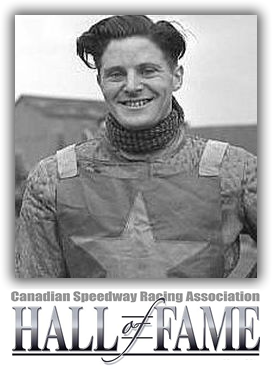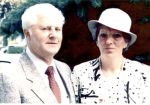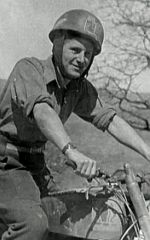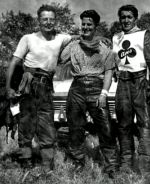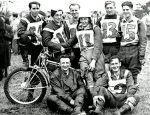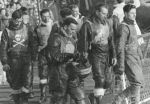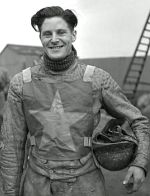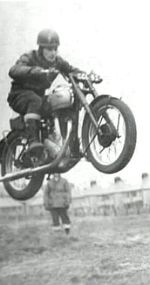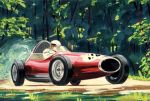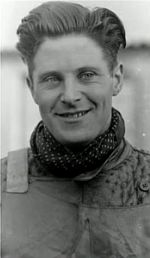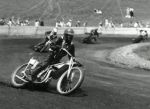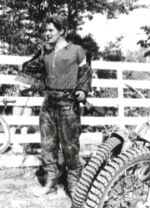GEORGE JEFFREY (JEFF) CRAWFORD
CLICK HERE for a fully comprehensive Bio provided by Canada's Speedway Historian. Mr. Tom Marriott.
____________________________________________________________
Born: Blackpool, Lancashire, England - 17th June 1927
Died: Brampton, Ontario, Canada - 27th February 2019
Jeff's interest in racing motorcycles started shortly after doing his Service in the army with the Lancashire Fusiliers and the South Lancashire Regiment. He was drafted into the army just after the end of the war with Germany but while hostilities were still in progress with the Japanese. Luckily, before he was shipped out there, the Atomic bomb ended that part of the war and Jeff saw out the rest of his duty to King and Country in Malta and as a border guard in Northern Italy, being retired to Civvy street in July of 1948 at the tender age of 21.
It was common in those days for young men to buy a motorcycle as a means of transportation, car s being very expensive to buy and maintain. In Jeff s case he became the owner of a 1948 BSA 350cc. One day in 1949 he and Bill Kitching (who was to become a lifelong friend), decided to go to Bolton to watch some grass track racing. While the two lads were waiting for the racing to start ( ) to their astonishment an announcement came over the public address system stating that the meeting was short of riders and was there anyone in the crowd who would like to try their luck at grass track racing. It didn t take long for the lad s to decide to try their luck.
After signing in they hurriedly stripped off parts of the machine to lighten the bike just like the early speedway riders did 20 years before. Both riders shared Jeff s machine and though they didn t win they thoroughly enjoyed themselves.
On returning home they decided that they would strip down the machine even further to make it more race worthy and so they became grass track riders. They rode regularly on the grass throughout 1949 and 1950 including on occasion taking part in team racing similar to regular speedway meetings
Whilst Jeff was racing on the grass in 1950 he was approached by Naaman Baldwin who was the team manager for the Fleetwood speedway team. So he went along to watch the Fleetwood Flyers to see what all the fuss was about.
Jeff liked what he saw and decided to try his luck at speedway and thanks to a bit of luck betting the triactor on horseracing! he went all out and spent his winnings on a new bike. He bought a new J.A.P. engine and a frame and with the help of a friend Don Potter who owned a local garage and was already riding for the Flyers, put it together on the morning of a practice. That afternoon he rode at the Fleetwood practice and thoroughly enjoyed himself. He also took the opportunity to practice on the sand track at Ainsdale on Sundays. (Unbeknown to him it was most likely that future friend and rider Stan Bradbury would also have been riding there at that time). He also gained experience practicing at Oliver Hart s cinder track at Coppel.
After a while Jeff s form at the practices earned him race night novice rides at the Fleetwood track. Soon he progressed to the point that he was offered a reserve spot for an away meeting. So off he went from Blackpool all the way down to Plymouth for two rides and no points! He then became the reserve of choice for the rest of the 1950 season , albeit only for away meetings! All told he rode in six meetings that year scoring 7 points in total for a match average of 1.75.
1951 started with Jeff in the Fleetwood team on a regular basis. Speedway was and is a demanding job requiring you to be away from work on race days. So Jeff had to make a choice either to commit full time to Speedway or stick with his trade as a sign writer. Jeff chose speedway and rode in all but one Fleetwood s official meetings that year.
1952 promised to be his breakthrough season but unfortunately the Flyers were not included in the League that year. As a result they were limited to only 20 meetings, running individual events and challenge matches. Even so Jeff rode well as we can see from his pay statements from two of the meetings.
On July 16th he rode against Cardiff in a challenge match and won all four of his races to earn his first 12 point maximum. To complete a special night for him he went on to win both his second half rides and go unbeaten on the night.
Two weeks later on July 30th he rode in an individual meeting scoring 14 points from 5 rides to finish tied for first place with Norman Hargreaves. As you can see doing well at Speedway in the early 50 s paid well! (Remember these figures are from 1952 when the average weekly wage would have been around 10 pound.
Also in 1952 Jeff raced in two meetings for the Liverpool Chads scoring 8 points from 6 rides for an average of 5.33 but sadly disputes between Fleetwood and Liverpool over the transfer fee led to the deal falling through.
1953 seemed to start off well with Jeff and fellow Flyers team mate Wilf Jay being transferred to Edinburgh. However they both had trouble getting the hang of the Edinburgh track and asked to be able to get some much needed practice on it. They were told to come to the track to get some practice only to be told on arrival that it had been prepared for the following meeting and they could not ride on it. So in essence they had to learn how to ride the track under race conditions and Jeff s average for the eleven meetings he rode for Edinburgh was 3.04 with 19 points from 25 rides.
At Edinburgh twelve riders were in competition for the eight team spots. This made it hard for Jeff to get a regular spot in the team. It was tough having to ride knowing that one bad meeting would relegate you to riding only in the second half races and Edinburgh was a long way from Blackpool. Frank Varey, who was the promoter at Edinburgh, also had interests in the track at Sheffield and Jeff was informed that he would be transferred to the Sheffield track for the 1954 season.
1954 came and sadly it was announced that Sheffield speedway would not open and shortly thereafter Edinburgh also closed down. Speedway was going through one of its darkest periods. Crippling taxes assessed to sporting events by the government of the day had led to many a track closing their doors. It would not be till the sixties when the Provincial League was launched that speedway would take off again.
Jeff tried to resurrect his flagging speedway career by riding a few second halves at Belle Vue. But with so many riders out of a job he returned to his old well paying job as a coach sign painter and gave up speedway for good or so he thought! He sold his trusted J.A.P. for a fraction of its worth as it was no longer a sought after motorcycle.
Fast forward to 1956 and a friend of Jeff s arrived back in the U.K. from Canada to help get immigration papers so that his wife could join him in Canada. Jeff liked what he heard about Canada and decided that he would go there with his old friend and booked his passage on the S.S.Olympia. In a twist of fate his friend s wife failed the physical so they stayed in England and Jeff took off to the unknown alone. He was glad to dock in Montreal as the trip over the Atlantic was horrible due to extremely choppy seas.
He started out with a job in Toronto doing sign painting before moving on to a position in the promotion department of a prominent newspaper, the Toronto Telegram. All was well as Jeff settled in to a new life in Toronto. Shortly thereafter his old friend Bill Kitching also emigrated and renewed his friendship with Jeff.
A few years passed then to Jeff s surprise he spotted an advert in a local newspaper and on TV about speedway starting up in Canada at a quarter mile trotting track on a farm in Dundas only 40 minutes away from Toronto. The print advert had the name of Trevor Valentine on it along with a phone number and once again Jeff s speedway racing desires flared up. He decided it was worth a phone call to Trevor to see what was going on and whether he needed riders.
It turned out that Valentine was promoting speedway in Canada for the first time and had ordered several used J.A.P. speedway bikes to be bought by the riders. Plans called for several meetings between Hamilton and Toronto to decide which team would win the Carling trophy.
The track was located on the Bar 11 ranch owned by local TV owner Ken Sobel (CHCH TV Hamilton)
Valentine located a leathers maker to supply race suits to the riders who needed them at a good price. Jeff was assigned to the Hamilton Team while his friend Bill Kitching was also signed up but to ride for the Toronto Team.
Given that speedway was somewhat new to the area the leathers maker measured Jeff and told him to come back at a specific date to pick up their suits. That day arrived and to Jeff s horror they were covered in metal studs! The company who made the leathers had mistakenly thought that the studs would be a benefit as protection to the riders. Needless to say Jeff removed all the studs and added some of his own padding into the suit for his own protection.
Bike allocation was also a hit and miss affair. Some riders such as Stan Bradbury and Bob Fisher had their own bikes but Jeff and Bill had to pick from the bikes owned by the promoter.. Bill being quicker than Jeff took the nice chrome one before Jeff could get to it. On to practice and Jeff soon found out he had not lost his skill at riding and took to the quarter mile Dundas track well.
Team speedway racing came to Canada on June the 6th 1959, when The Hamilton team faced off against Toronto. Along with Jeff there were other ex British riders in the meeting. Allan Kidd and Mike Tams rode for Hamilton as did Dave Dodd, who would eventually go to England to race at Poole and Liverpool, while Bingley Cree and Johnnie Sargent lined up for Toronto. The meeting was run over 16 heats and had some unique races as several of the riders rode stock motorcycles as there were not enough JAP bikes to go around. (Stock bikes did not ride with the J.A.P s)
In a hard fought meeting Hamilton came out on top 58 38. Riding unbeaten was Allan Kidd with Jeff getting a paid maximum following home Alan in heat four. As for Bill Kitching he did not score a point but did give the crowd their biggest thrill when in heat 11 he made a terrific start and headed into the first bend at full throttle. Sadly he failed to negotiate the turn and went heavily into the boards! He wrecked the bike and hurt his head and wrist but said he would be back next week. For Hamilton Mike Tams scored 7 points and Dave Dodd 6 points. For the Toronto team Bingley Cree scored 9 points, Jim Campbell 9 points and Johnnie Sargent a disappointing 6 points. Sadly for the promoter the crowd was dismal and it was hoped that things would pick up next week.
All in all a good afternoon s work for Jeff and he was looking forward to racing in the next meeting on June 20th .
The second meeting of the Hamilton v Toronto series was held on Saturday the 20th 1959 back at the Bar 11 ranch in Dundas. In this meeting the Toronto team was strengthened by the inclusion of Stan Bradbury and Ron Tuck both of whom had ridden in England before emigrating to Canada. The meeting was much closer than the first one but Hamilton still managed to come out on top 52 44 bringing the aggregate score to 110 82 in their favour.
Once again Jeff had a great meeting but failed in his bid for a maximum being beaten by Johnnie Sargent. Nevertheless he still top scored in the meeting. Along with Jeff the leading scorers for Hamilton were Mike Tams 10, Allan Kidd 9, Dave Dodd 7 while for Toronto it was Johnnie Sargent 9, Bingley Cree 8, Sandy Freeman 7, Bill Kitching 5. It should be noted that Fred Tuck s bike was still in customs and he had a tough time with 1 point. Stan Bradbury had an even worse day scoring zero!
During the meeting Allan Kidd lowered his existing track record by a full second to 80.2 seconds but the extremely poor attendance, despite Promoter Valentine spending heavily on advertising, cast a major cloud over the event.
The third speedway meeting in Dundas was to be held on Saturday June the 27th but the promoter Trevor Valentine pulled out to cut his losses. The riders wanted to continue so they took over the promotion of the series. On the day of the meeting Ontario was experiencing a heat wave with a temperature of 87 degrees F at race time.
Add to that a high humidity index and it was like racing in a sauna. But as they say the show must go on. With all the riders in the meeting wearing black it was extremely uncomfortable for them.
It was decided that this would be an individual meeting with the best JAP rider taking on Harley rider Jim Campbell to settle the bet which is the better dirt track racing machine and rider.
The riders tried hard to put on a show in the less than ideal conditions but even a short rainfall did nothing for the humidity. Things were going from bad to worse when Mike Tams fell hard but got up only to fall down whilst walking to the pits due to sunstroke. By heat ten no fewer than 5 other riders had collapsed including Jeff. In the end the riders had no other option than to call a halt to the meeting.
The last meeting to be held at Dundas was on Wednesday July the 1st 1959 a Canadian Holiday. Yet another individual championship was held instead of a team meeting.
It started with a crash on the first bend lap one when Allan Kidd went down in a heap and Mike Tams had to lay his bike down and somehow Ron Tuck lost a chain! It was decided that they would move on to heat two. (Heat 1 never was run again!) Jeff was up in heat two along with Dave Dodd, Bingley Cree and Johnnie Sargent and Jeff won it in fine style. Out again in heat four he was up against Allan Kidd, Johnnie Sargent and Fred Tuck. With Allan finishing 1st in a time of 82 seconds Jeff had to settle for second place. Out in heat 8 he again had to settle for second , this time against a much improved Stan Bradbury. In heat 11 disaster struck as he suffered a rare engine failure. Back out again in heat 12 with little time between he got his revenge on Stan by relegating him to second place. Next Jeff was up against Allan Kidd in what proved to be not only the last speedway race at Dundas but also the final one of Jeff s career. Try as he might the race was won by Alan and Jeff finished the meeting in second place.
Spirits were high as to speedway making a comeback in 1960 but it was not to be and Canadian Speedway was in the wilderness except for exhibition racing by Stan Bradbury and Bob Fisher until it re emerged at Welland County Speedway in the early 70 s.
At the end of 1959 Jeff was listed as Canada s 2 rider behind Allan Kidd. He was still in his prime as a speedway racer but there was no place for him to ride. Had he still been in Great
Britain it would have been highly likely that he would have been given a team place in the new Provincial League of 1960 and would have been challenging for a heat leader role.
With Speedway having come to an end in Canada Jeff once again went back to his full time job at the newspaper in Toronto. However he still had the bug to race so he went to Quebec with a machine converted to race on the ice.
But this didn t last long and his thoughts turned to four wheel racing. He teamed up with old friend Bill Kitching and they decided to build and race 2 formula junior race cars which they would use for circuit racing and Hill Climb events.
In 1960 and 61 Jeff raced the Sprite engine Formula Junior car in events at the Ontario, Canada racetracks at Mosport, Goderich and Harewood Acres.
Jeff also raced the car in Hill Climb events around Toronto and was successful as can be seen in the next two photos.
After a short but successful career on the race track Jeff settled down back at the Newspaper promotions department. He is happily married to Linda a Canadian girl and his son Darren was also a sportsman playing ice hockey as a goalkeeper.
Jeff lives in Brampton, which is on the outskirts of Toronto, Ontario, Canada. He has become a computer buff in his later years but still has managed to combine his new hobby with his old passion. Not only does he avidly follow the Formula 1 GP s on his TV he also plays his Formula one racing game via the computer on his big screen TV from a converted chair in his recreation room in his basement!
Thanks to Jeff Crawford, Duncan Luke and Matt Jackson for their help with this article.

|

